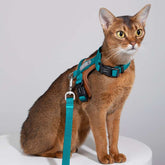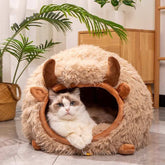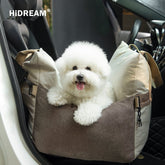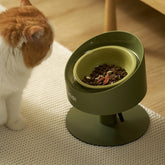Guide To Choosing The Best Litter For Your Cat

When it comes to choosing the best litter for your cat, there are a lot of factors to consider. You might want to find something that will not only keep your feline friend's litter box clean but also avoid situations that will compromise your comfort, time, and budget.
Cat litter can be made from sand, clay, pine, wheat, or recycled paper. This can also be scented to help mask odors. How do you choose the best litter for your cat? This article will help you decide which type of litter is best for you and your cat.
Factors to consider when choosing litter for your cat
Clumping or non-clumping cat litter
There are many benefits to clumping cat litter.
Bentonite, a common ingredient in clumping cat litter, is essential for absorbing liquids. The solid clumps make it easier to clean and also prevent plastic contamination.
Note: Clumping cat litter can last longer than non-clumping litter. However, clay litter can be dusty and non-biodegradable.
Non-clumping cat litter is difficult to clean and has a high chance of tracking. You don't want your cat litter box to become stained and need to be replaced. If you have to choose, go with the clumping cat litter, as it will ease the cleaning work and older cats prefer it. If you have kittens, avoid clumping cat litter, as they’re likely to eat it, which could cause blockages.
Scented or unscented choices
Scented litter is ideal for masking the odor from your litter box. However, cats have a better sense of smell than humans, and some scents could be repellent. It is important to determine your cat’s preferences to know what’s best. It’s essential to use cat litter that eliminates odors rather than masks them. If you can’t find it, avoid scented cat litter, as it might cause more problems than it solves. It’s better to clean your litter box every day than for your cat to have respiratory issues.
Go for dust-free cat litter
If you are allergic to dust or suffer from asthma, avoid cat litter with such additives. However, you may need to test several different types of cat litter to find the right one for you and your cat. You should also monitor your cat’s reaction to different litters to know if they’ve developed an allergic reaction.
Consider your cat's comfort
It’s no secret that cats love to play and relive themselves in fine sand. This is because they can dig their droppings into the sand easily. When choosing the best litter for your cat, it’s best to find litter with a similar texture to sand. Fine-grain litter and clay-based litters are ideal for this. If you own a declawed cat, go for a gentle litter. This will prevent your cat from avoiding the litter box.
The number of cats using a litter box
Different cats have different preferences. While one cat might love one type of litter, the other might not be comfortable with it. For instance, if you have multiple cats, you might have to find a separate litter box for both.
Types of cat litter

Clumping clay cat litter
The clumping clay litter comes first. It’s manufactured using bentonite clay, which is very absorbent. Bentonite makes it possible for the litter to form a solid clump after absorbing cat waste. Clumping clay cat litter is easy to do and also reduces odors.
Pros
- It is good at drying out urine, poop and absorbing odors.
- It doesn’t require frequent replacement.
Cons
- Not recommendable for kittens under six months, as they could ingest it while cleaning their paws, leading to serious health issues.
- You’ll have to deal with lots of litter tracking and dust.
Non-clumping clay litter
This is an excellent alternative to clumping clay litter if you want to reduce odors in your litter box. It’s manufactured using baking soda, charcoal, and other special odor-reducing ingredients.
Pros
- It’s safe for cats of all ages. A young kitten can ingest it since it won’t clump or cause any health problems.
- Less dusty and hence suitable for cats and their owners with respiratory problems.
Cons
- Not environmentally friendly since it's not biodegradable.
- More time is required to clean the litter box since it’s unable to clump.
Corn-based cat litter
Corn-based cat litter is a good option if you’re looking for biodegradable and environmentally friendly cat litter. It’s made of compressed corn.
Pros
- It’s eco-friendly and biodegradable.
- It has higher clumping abilities compared to clay litter.
- It's easy to dispose of since it's flushable.
Cons
- It can produce dust, which is harmful to pets and asthmatic or allergic cat owners.
- Mold growth and harmful aflatoxins can easily reduce their clumping abilities.
Cat litter made of silica gel

Silica crystals are known for minimizing humidity and preventing odors. Since silica crystals can absorb up to 40 times their weight, they make excellent clumping cat litter.
Pros
- Durable compared to other alternatives
- It aids in the control of odors and the removal of dust from the home.
Cons
- Pricier than clumping and non-clumping litter.
- The crystals’ rough texture might not be ideal for young kittens and older cats with sensitive paws.
- When consumed in large quantities, it may cause health problems.
Walnut cat litter
Walnut cat litter consists of crushed walnut shells and a natural material that can be easily disposed of. There are three types of walnut shell cat litter: fine, coarse, and pellet. Walnut cat litter is biodegradable and low-tracking.
Pros
- It’s highly absorbent.
- excellent for controlling odors
- You can choose the latter texture if you have cats with sensitive paws.
- Walnut cat litter is eco-friendly.
Cons
- It can be dusty and might cause a health challenge to the cat and its owner.
Pine-based cat litter

Pine-based cat litter is made from pine sawdust, a byproduct of lumber mills. Manufacturers heat the pine shavings to remove oils, toxins, and other allergens. The heat treatment results in the pine being compressed into pellets or shaped into granules.
Pros
- It has clumping abilities.
- less expensive than any other biodegradable cat litter.
- It’s dust-free
Cons
- The scent only masks the odor rather than controlling it.
Paper-based cat litter
This cat litter is made of recycled paper and is suitable for the environment. Because it's not fine-grained, paper cat litter is ideal for declawed or injured cats. It’s also absorbent.
Pros
- Dust-free and unscented, it is, therefore, suitable for both the cat and its owner.
- Ideal for cats with sensitive skin or injured cats
- It's environmentally friendly since it's biodegradable.
Cons
- It doesn’t control odors, so it needs frequent replacement and cleaning.
Wheat cat litter
Ground wheat, also called secondary wheat, is used to make this cat litter. It is a biodegradable form of cat litter. Like other types on the list, wheat-based cat litter clumps well and has odor control. It is also an affordable cat litter.
Pros- Biodegradable, eco-friendly, and flushable
- Effective for odor control
Cons
- It can create a lot of dust, making it unsuitable for allergic and asthmatic cats and cat owners as it can lead to respiratory problems.
- It can develop aflatoxins, which can be fatal to cats.
Cat litter made of grass seed
It's made from grass fibers. It’s the ideal litter for anyone who loves traveling with their cat since it’s packed in light bags.
Grass seed litter is soft and similar to sand, and it's perfect for cats with sensitive paws. It can either be clumping or non-clumping.
Pros
- It has a fainter scent than other cat litter.
- It’s an excellent clumping litter.
- lightweight and biodegradable
Cons
- It’s more expensive than all other types of cat litter.
- It is difficult to reduce litter tracking.
Questions you might have...

Is cat litter safe?
Cat litter is safe; however, it’s not suitable for consumption. For instance, clumping litter is not recommended for kittens, as it causes gastrointestinal problems if ingested. Also, keep your dogs away from the litter, as they will be tempted to eat it.
What is the most effective type of litter?
If you want to buy litter for your cat, it's best to get the kind they're used to. This is more pronounced for cats trained to use a litter box. The ideal cat litter should be non-scented, dust-free, clean, clumping, and not dangerous for cats with sensitive paws.
Cats are used to a routine, and if you change the litter, they’ll be reluctant to use the litter box. In nature, cats enjoy having identical litters with their kind be reluctant to use the litter box. In nature, cats enjoy having identical litters with their kind. For cats and kittens that used to live outside, it is possible to use sand or dirt instead of litter during litter box training.























